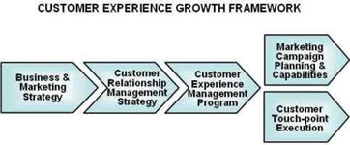Growth comes only from increased purchase rates. Purchases are decisions customers make based on their needs and expectations. If you are relevant — or even better are already a positive and necessary part of your customer’s experience — then you have the chance to increase growth. So how in the complex multichannel, high-noise, customer-controlled world do you get that relevance and growth?
Become a master of the customer touch point
Relevance and purchases are in the end the two measures that matter to marketers. Relevance begins with interactions with a customer as he tries to satisfy a need. Every interaction – with mass advertising or direct marketing; through a partner, an agent, or a channel; at any time of the customer’s choosing – is a touch that either builds or destroys the potential for your company to grow.
Organizations that adopt a disciplined approach to developing greater relevance at these touches are reaping the benefits. Consider the following:
• A large pharmaceutical organization realized a 60-times-over ROI when it leveraged the insights it gleaned from a customer experience touch-point map and customer segmentation work to focus its sales and marketing efforts.
• Sodexho, a food and facilities management organization, has leveraged customer feedback to improve its customers’ experience, resulting in a 46% increase in service retention.
• BearingPoint, a business consulting, systems integration, and managed services firm, uses customer segmentation insights to improve marketing communications and programs, resulting in an average response rate of 60%.
• Vignette, a computer software organization, has used customer experience management (CEM) to focus on its top customers, generating a 22% rise in revenue from targeted accounts in one year.
Each of these companies achieved the success they desperately needed by moving beyond “traditional” sales and marketing tactics to an organization-wide tool and process for improving the most important points where a customer touched its products, service, or communications.
Customer touch-point discipline benefits the organization by
• driving more profitable business throughout a customer lifecycle. At a minimum, companies using touch-point mapping have achieved an ROI of five to seven times on deploying that tool, with many organizations receiving almost unbelievably higher returns.
• identifying unmet needs across the customer lifecycle. This provides marketing with insights to determine which channels and messages should be deployed to specific customer segments with the goal to convert that purchase potential.
• sustaining growth through increased (unconscious) preference and future purchase retention. Marketers monitor touch points for customer advocacy and provide a more consistent and relevant experience than competitors.
• improving the capture, integration, and cross-organizational sharing of customer data so that the company can treat customers the way they want to be treated and make it far easier for them to do business with the company.
The next great frontier of growth
Opening the next great frontier of growth will certainly involve disciplined management of customer touch points as a CEM practice. This entails understanding and proactively managing your customers’ needs, expectations, and experience as they progress through their relationship with your company and its partners.

The CEM growth framework helps companies focus on the five key elements from strategy through execution. The new common thread across these five elements is knowledge of what is happening at your most critical touch points through the customer lifecycle. It is built through disciplined management requiring the application of new touch-point mapping tools arriving in the market.
But this is much more than a one-time process or tool installation. It is an ongoing discipline that is necessary if your company truly expects to harness the value of its customers by managing its customers through each and every interaction.
There are five steps to deploying the CEM growth framework. Each step builds upon the previous, providing insights and information to help you better assess your customer segments and customer needs, create the most-relevant messaging, and gather feedback to improve customer experience and marketing performance:
1. Talk to your customers. The goal is to better understand customer interactions with a focus on needs, levers, and efficiency.
2. Create a customer experience touch-point map. This provides a physical representation of your customers’ experiences with your company.
3. Evaluate the experience from the customer’s view. Determine the value of individual touch points to the customer and the organizational alignment of processes and technology that affect the customer experience.
4. Recommend a future state. Create a compelling “burning platform” for change, vision, and first actions.
5. Create buy-in and action. Develop continuous innovation and adoption to drive CEM.
Armed with innovative new touch-point mapping tools and the CEM growth framework, you will uncover long-hanging fruit that you could not even imagine. Right now, that the fruit is ripe, real, and ready for you–or your competitor–to harvest.
Lane Michel is executive vice president/managing director of the Marketing Performance Management business unit of Quaero Corp., a marketing and technology services provider based in Charlotte, NC. You can reach him at lane@quaero.com.
Other articles by Lane Michel;
Marketing Resource Management: Delivering Predictability
Marketing Budgets: Zero Sum Wins
Analytics in Perspective: Keep It Simple and Relevant
Analytics in Perspective: Lessons from Sudoku
The Six Dimensions of High-Performance Marketing
Marketing Performance Management: The Case for Customer Experience Management
Marketing Performance Management: Break Conventional Marketing Wisdom



